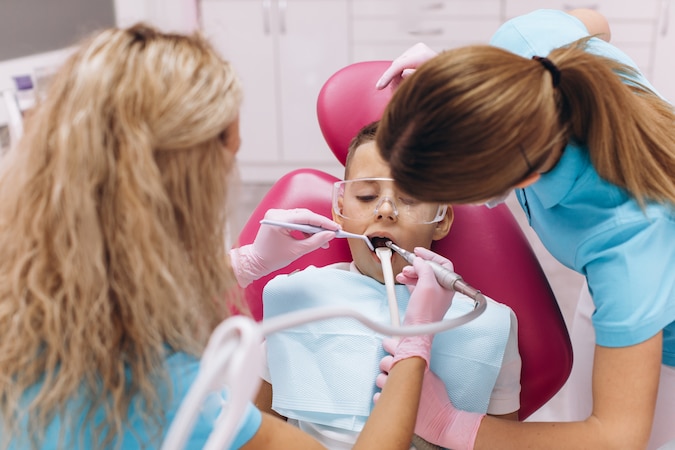
How to Prevent Early Childhood Cavities Effectively

Preventing early childhood cavities involves a combination of healthy oral habits, balanced nutrition, and regular dental visits. By taking simple yet effective steps, you can protect your child’s smile and set them up for a lifetime of good oral health.
Early childhood cavities are a widespread issue that can lead to pain and long-term oral complications. By implementing proper dental hygiene, offering nutritious snacks, and making timely dental visits, you can prevent cavities and ensure your child has strong, healthy teeth. For more on protecting your family’s overall health, consider exploring SelfGood for affordable health insurance options.
Key Takeaways:
- Start brushing your child’s teeth as soon as the first tooth appears.
- Limit sugary snacks and drinks while encouraging healthy alternatives.
- Regular dental visits should begin by the child’s first birthday.
- Fluoride is crucial for strengthening young teeth and preventing decay.
- Avoid letting children fall asleep with bottles of milk or juice.
Understanding Early Childhood Cavities

Early childhood cavities develop when tooth enamel breaks down due to acid produced by bacteria that feed on sugar. As sugars from snacks or milk interact with bacteria, acids form and erode teeth. These cavities can cause discomfort, infections, and other complications if untreated.
Causes of Early Childhood Cavities
Several factors contribute to the formation of cavities in young children:
- Oral Bacteria and Sugar: When bacteria feed on sugars in the mouth, they produce harmful acids. Frequent exposure to sugary foods and drinks accelerates this process1.
- Poor Oral Hygiene: Without regular brushing and flossing, plaque builds up and weakens enamel.
- Frequent Snacking and Bottle Feeding: Constant snacking and prolonged use of bottles (especially at night) expose teeth to sugars, increasing cavity risk.
The Importance of Early Dental Visits
Starting dental visits early sets the foundation for a lifetime of oral health.
- When to Start: The American Dental Association (ADA) recommends scheduling the first dental visit by the child’s first birthday2.
- Why It Matters: Early visits can prevent decay, familiarize children with the dentist, and catch issues early.
- Preventive Benefits: Dentists can apply fluoride treatments, offer advice, and monitor the child’s oral development.
Establishing Good Oral Hygiene Habits
Creating a fun and engaging routine for dental care can help children build lifelong habits.
- Brushing Techniques: Use a soft-bristled toothbrush and fluoride toothpaste. Brush for at least two minutes, twice daily. Until age six, assist or supervise your child to ensure proper brushing.
- Choosing the Right Products: Select toothbrushes made for children and use age-appropriate fluoride toothpaste.
- Introducing Flossing: Once teeth touch, gently floss daily. Floss picks designed for kids can make it easier and more enjoyable.
Dietary Tips to Prevent Cavities
Diet plays a crucial role in oral health. Making wise food choices can minimize decay.
- Limit Sugary and Acidic Foods: Reduce sweets, juice, and starchy snacks. Offer alternatives like fruit, yogurt, or cheese, which help neutralize acid.
- Healthy Snacks: Choose tooth-friendly options like crunchy vegetables, whole fruits, or dairy products. These can stimulate saliva production and wash away food particles.
- Encourage Water Over Sugary Drinks: Water is essential for rinsing teeth and preventing dry mouth. Fluoridated water also strengthens teeth3.
- Snack Timing: Avoid continuous snacking. Keep mealtimes structured to minimize prolonged acid exposure on teeth.
The Role of Fluoride in Cavity Prevention
Fluoride is a mineral that helps protect teeth from decay.
- How Fluoride Works: It strengthens enamel, making teeth more resistant to acid. Fluoride can be found in toothpaste, some drinking water, and professional treatments.
- Safe Use: Use only a small amount of fluoride toothpaste and teach your child to spit it out.
- Community Water Fluoridation: If your water isn’t fluoridated, discuss supplements with your dentist.
Preventive Treatments and Sealants

Dental sealants and other treatments add extra protection.
- Dental Sealants: Thin coatings applied to molars protect against decay. Your child’s dentist can advise on the best time to apply them.
- Other Treatments: Fluoride varnishes and professional cleanings further reduce cavity risk.
Avoiding Baby Bottle Tooth Decay
Preventing cavities linked to bottle use involves strategic changes.
- Why Bottles Cause Decay: Milk, formula, and juice contain sugars that harm teeth if they remain on teeth overnight.
- Weaning Off Bottles: Gradually transition from bottles to cups. Offer water instead of sugary drinks at bedtime.
- Healthy Bedtime Practices: After your child’s last meal, brush their teeth and only offer water until morning.
Teaching Children Healthy Dental Habits
Making dental care engaging helps establish consistency.
- Fun Brushing Techniques: Use timers, play music, or let your child choose a fun toothbrush.
- Positive Reinforcement: Reward consistent brushing with stickers or small prizes.
- Family Participation: Brush together to make it a shared activity. Children mimic what they see, so set a good example.
Final Thoughts
Preventing early childhood cavities requires a proactive approach. By encouraging proper oral hygiene, offering nutritious foods, and scheduling regular dental visits, you can set your child up for lifelong dental health. Small daily habits have a lasting impact, so start today for a future full of healthy smiles.
Frequently Asked Questions
When should I start brushing my child’s teeth?
Start brushing as soon as the first tooth appears. Use a tiny smear of fluoride toothpaste and a soft brush.
How much toothpaste should I use for my toddler?
For children under three, use a rice-sized amount of fluoride toothpaste. For those aged three and up, a pea-sized amount is ideal.
Can I use mouthwash for my young child?
Mouthwash is generally not recommended until your child can spit it out properly, usually around age six. Always consult your dentist.
Sources:
- Centers for Disease Control and Prevention. (n.d.). Children’s Oral Health. Retrieved from https://www.cdc.gov/oralhealth
- American Dental Association. (n.d.). First Dental Visit. Retrieved from https://www.mouthhealthy.org
- HealthyChildren.org. (n.d.). Oral Health. Retrieved from https://www.healthychildren.org




